Are you a succulent enthusiast or just starting to explore the world of these fascinating plants? You have probably seen an Agave americana variegata ‘Variegated Century Plant’. This striking plant is known for its stunning appearance and intriguing life cycle. In this comprehensive guide, we’ll cover everything you need to know about this unique plant, from its growth habits to its care requirements.

Dig in!
Agave americana ‘Variegated Century Plant’ Appearance and Growth
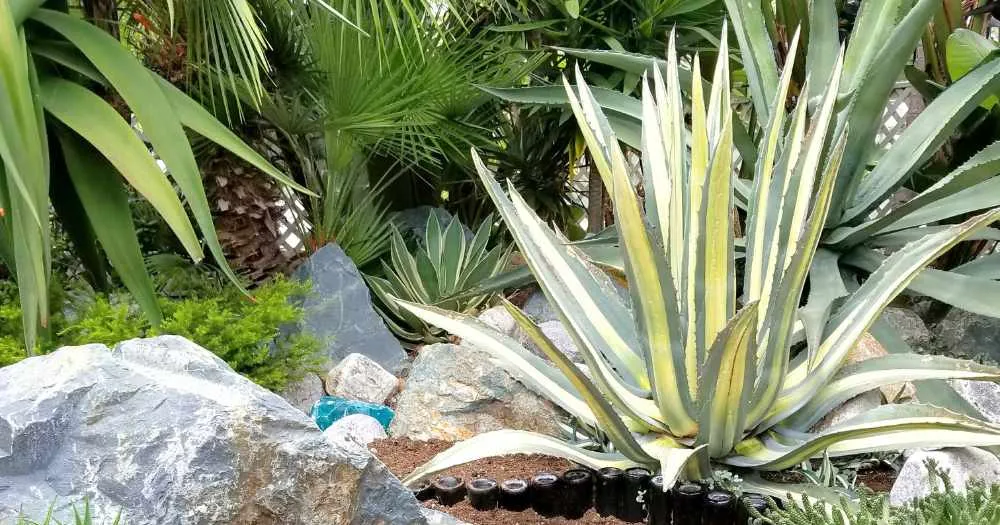
Size
Agave americana variegata ‘Variegated Century Plant’ is a large succulent that can reach impressive sizes. Mature plants can grow up to 6 feet tall and 10 feet wide, with leaves that can be 3 feet long and 6 inches wide. The plant’s leaves are blue-green with creamy-yellow margins, giving it a striking appearance that makes it a great focal point in any garden.
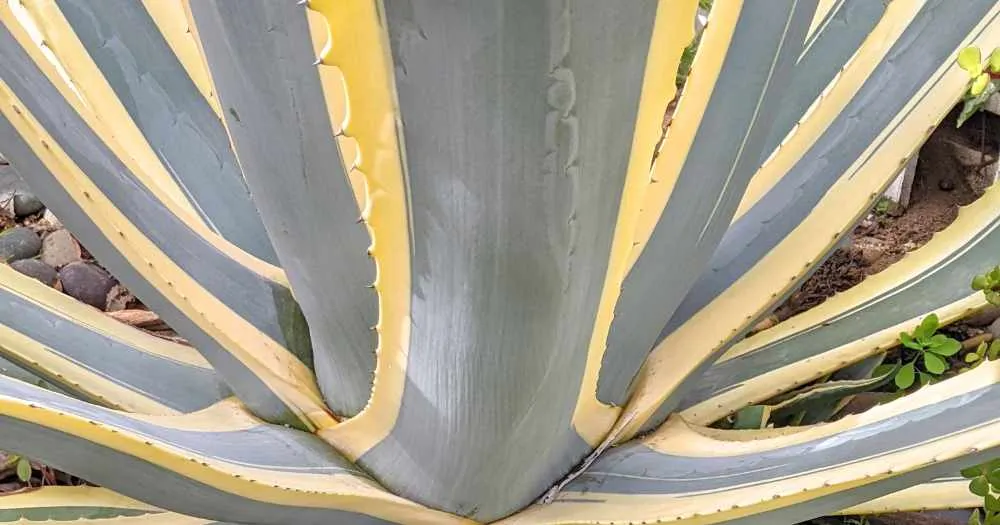
Cold Hardiness
Agave americana variegata ‘Variegated Century Plant’ is relatively cold hardy for a succulent. It can withstand temperatures as low as 15°F (-9°C) without suffering significant damage. However, it’s essential to protect the plant from frost and prolonged freezing temperatures to avoid any potential harm.

Sun or Shade Preference
Agave americana variegata ‘Variegated Century Plant’s prefer full sun but can tolerate some shade. Ideally, they should receive at least 6 hours of direct sunlight per day. Too much shade can cause the plant to become leggy and lose its vibrant coloration.

Agave americana ‘Variegated Century Plant’ Blooming Cycle and Life Span

Frequency of Blooms
Agave americana variegata ‘Variegated Century Plant’ is a monocarpic plant, which means it only blooms once in its lifetime. It typically takes about 10 to 30 years for the plant to reach maturity and produce a flower stalk.
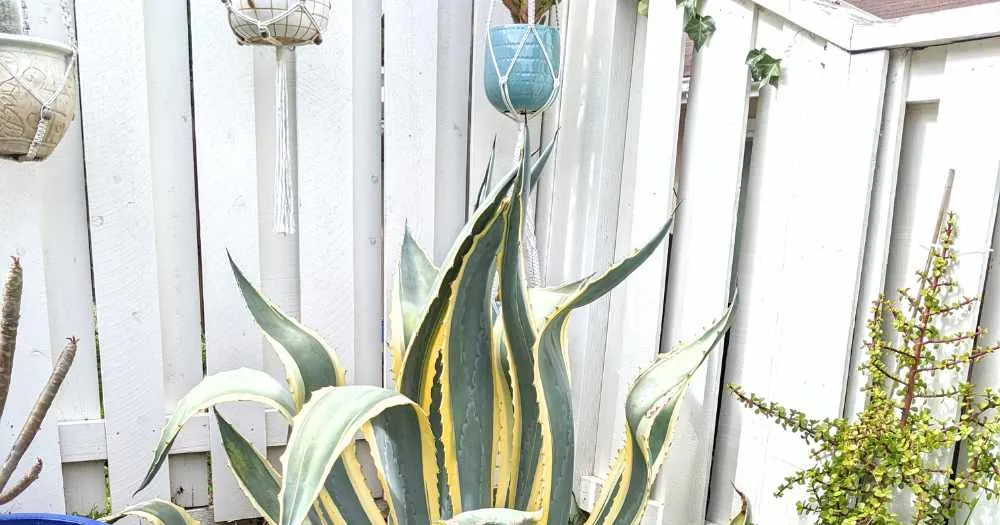
Time to Bloom
The blooming process can take several weeks to a few months, depending on the plant’s size and environmental conditions. The flower stalk can grow up to 30 feet tall, with clusters of yellow-green flowers at the tip.

Agave americana ‘Variegated Century Plant ‘Life After Flowering
Once the ‘Variegated Century Plant’ Agave americana variegata has bloomed, it will start to decline and eventually die. However, it usually produces several “pups” or offsets around its base, which can be separated and grown as new plants.
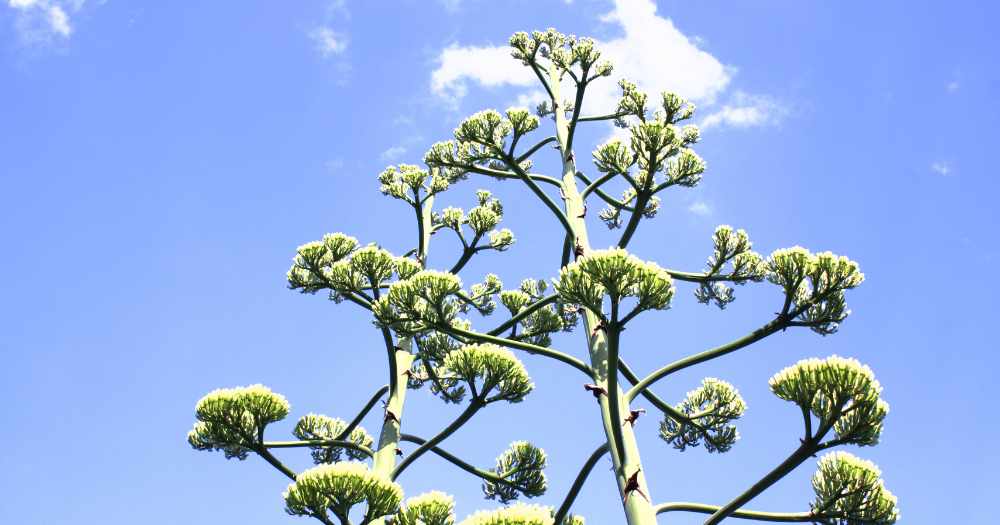
‘Variegated Century Plant’ Care
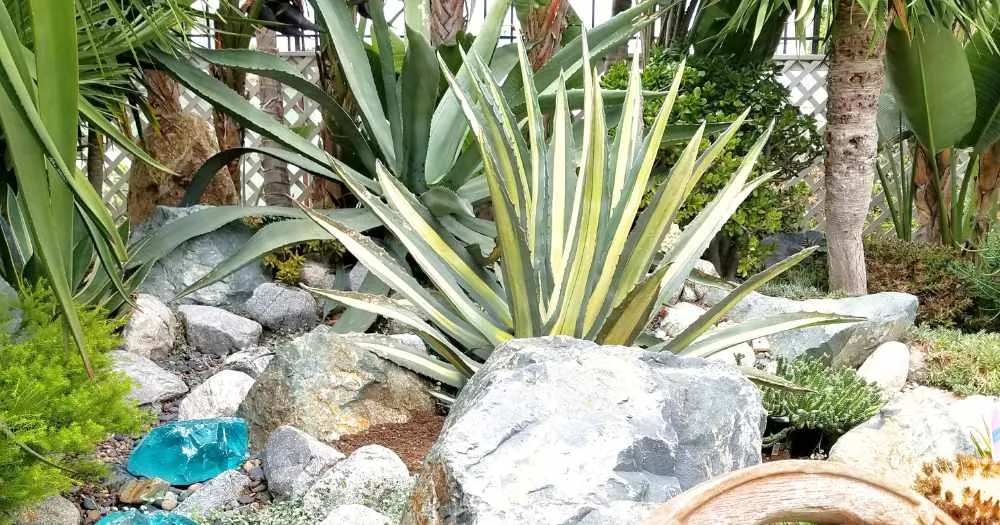
How to Water Agave americana ‘Variegated Century Plant’
Like most succulents, Agave americana variegata ‘Variegated Century Plant’ prefers infrequent watering. Allow the soil to dry out completely between waterings to prevent root rot. In general, water the plant every 2 to 4 weeks during the growing season and even less during the winter months.

Soil Requirements for Agave americana ‘Variegated Century Plant’
The ‘Variegated Century Plant’ Agave americana variegata requires well-draining soil to thrive. A mixture of equal parts potting soil, coarse sand, and perlite is ideal. Ensure the planting area has good drainage to avoid standing water, which can cause root rot.

Container vs. Ground Planting
This agave species can be grown in containers or planted directly in the ground. If planting in a container, choose a large, sturdy pot with drainage holes. Keep in mind that, due to its size, ‘Variegated Century Plant’ Agave americana variegata may eventually outgrow its container and require transplanting.

Winter Protection
In areas with harsh winters, it’s essential to protect the ‘Variegated Century Plant’ Agave americana variegata from frost and freezing temperatures. Cover the plant with frost cloth or move it indoors if it’s in a container.

Common Questions and Concerns
Agave Snout Weevil
The agave snout weevil is a common pest that can affect Agave americana ‘Variegated Century Plant’. The weevil is a type of beetle that feeds on the agave plant, causing damage to the leaves and stem.
The weevil is most active during the warmer months and can be identified by its long snout and black or brown body. Signs of infestation include wilting leaves, holes in the leaves and stem, and a foul odor from the plant. If your Agave americana ‘Variegated Century Plant’ looks like it has melted, you’ve unfortunately been hit by the agave snout weevil.

To prevent infestation, it’s important to inspect plants regularly for signs of damage and to remove any affected plants immediately. It’s also recommended to use insecticides or natural remedies to control the weevil population.
Agave americana ‘Variegated Century Plant’ Death Bloom
The term “death bloom” refers to the flower stalk that the ‘Variegated Century Plant’ Agave americana variegata produces before it dies. Although it signals the end of the plant’s life, it also offers an opportunity for new plants to growfrom the offsets or “pups” it leaves behind.
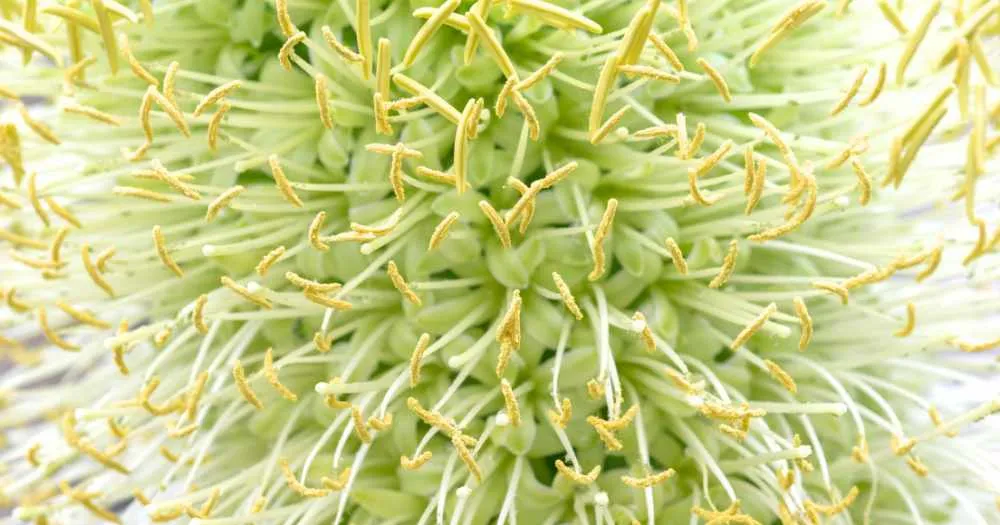
Is Agave americana ‘Variegated Century Plant’ a Succulent or Cactus?
While Agave americana variegata ‘Variegated Century Plant’ may resemble a cactus, it is actually a succulent. Both cacti and succulents store water in their leaves and stems, but they belong to different plant families. Agaves are members of the Asparagaceae family, while cacti belong to the Cactaceae family.
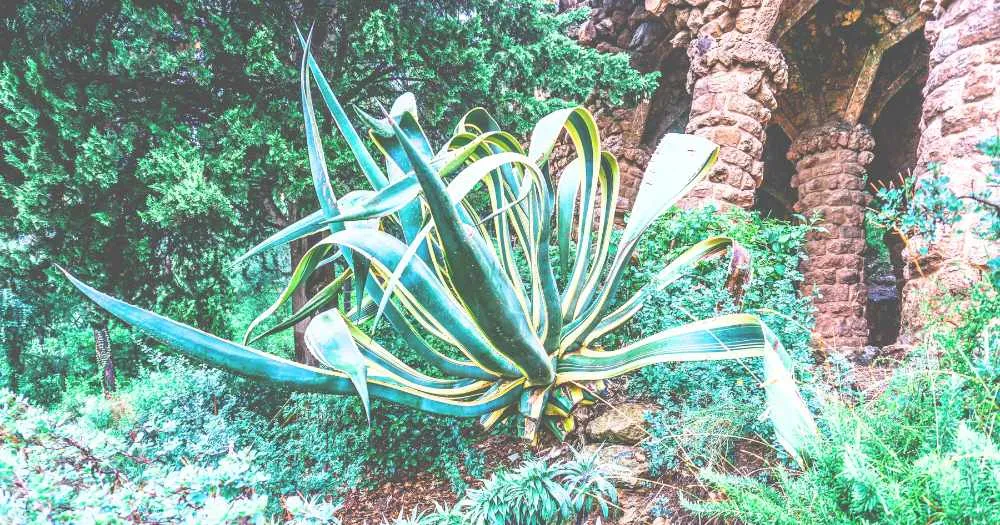
Agave americana ‘Variegated Century Plant’ Toxicity
Agave americana variegata ‘Variegated Century Plant’ contains compounds called saponins, which can be toxic to humans and animals if ingested. Additionally, the sap can cause skin irritation in some individuals. It is essential to keep the plant out of reach of children and pets and to wear gloves when handling it.

Invasiveness
In some regions, Agave americana ‘Variegated Century Plant’ and its cultivars are considered invasive due to their ability to spread rapidly by producing offsets. If you live in an area where this plant is considered invasive, it’s crucial to manage its growth and prevent it from spreading to natural habitats.
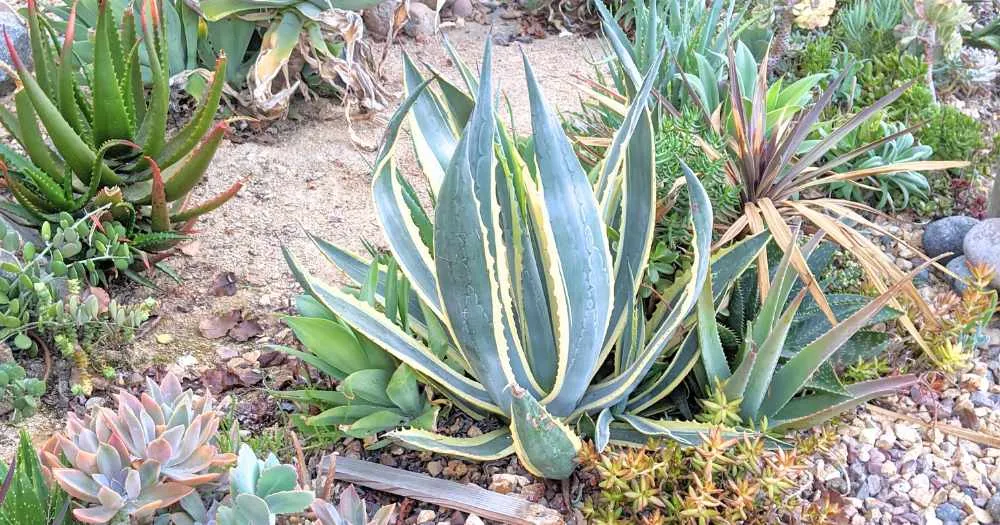
Agave Americana Life Cycle: Exploring the Fascinating Journey
Seed Germination: A Delicate Beginning
The Agave Americana life cycle commences with the delicate process of seed germination. Optimal temperatures ranging between 75-90°F are required to initiate this critical phase. However, in the wild, germination rates are irregular and often quite low. Nature’s selective process comes into play, ensuring only the hardiest seeds survive to become part of the next generation.
Seedling Phase: Slow and Steady Growth
Once the seeds successfully germinate, the Agave Americana enters its seedling phase. During this time, the plant takes the form of a small rosette, representing the budding potential that lies within. However, growth in this early stage is exceedingly slow, with the plant showing only modest progress during the initial 3-5 years.
Rosette Phase: Flourishing into Splendor
As the Agave Americana matures, it enters the rosette phase, a period of robust growth and development. During this stage, the plant forms a large rosette comprising thick, fleshy leaves. These rosettes can extend up to an impressive 6 feet in width, creating a striking sight in their natural habitat. The rosette phase endures for a considerable span of 10-20 years, providing ample time for the plant to flourish.
Flowering: The Grand Finale
One of the most captivating moments in the Agave Americana life cycle is the flowering phase. Once the plant reaches maturity, a tall and stately flower stalk emerges from the center of the rosette. This extraordinary stalk, growing up to 40 feet in height over several weeks, commands attention and fascination. During this time, small yellowish flowers bloom on side branches, adding a touch of elegance to the spectacle.
Seed Set: Nature’s Cycle Continues
The flowering event serves a pivotal purpose in the life of Agave Americana. Flowers act as nature’s signal, inviting bats, birds, and insects to partake in the pollination process. These natural agents facilitate the setting of hundreds of small black seeds, paving the way for the next generation. However, it is essential to note that the mother plant, having fulfilled its life’s purpose, ultimately meets its demise after flowering.
Death and New Beginnings
Death is not the end for the Agave Americana; instead, it marks the beginning of a new chapter. While the mother plant may perish after its grand flowering event, it leaves behind a legacy in the form of “pups.” These plantlets emerge from the base of the deceased plant, carrying on the growth and life cycle. Over time, entire colonies are formed through this remarkable process, ensuring the continuity of the species.
Lifespan: A Tale of Resilience
The lifespan of Agave Americana is a testament to its resilience and adaptability. On average, these majestic succulents live for 10-30 years, gracefully navigating through the stages of their life cycle. Interestingly, under stressful conditions, some plants may flower sooner, highlighting their ability to adapt to environmental challenges. In ideal conditions, these hardy plants can live for 80+ years before embarking on their grand flowering journey.
Ready to add the Agave american variegata ‘Century Plant’ to your collection?
Click on the image below to buy a rooted ‘Century Plant’ pup from a small business on Etsy and watch your Agave americana variegata’s life cycle in real time! It is hard to believe that these minuscule babies turn into huge plants!

The ‘Variegated Century Plant’ (Agave americana variegata) is a stunning and unique succulent that can be a great addition to any garden. With its impressive size, striking appearance, and intriguing life cycle, this plant is sure to be a conversation starter. By following the care tips and guidelines provided in this comprehensive guide, you can ensure that your ‘Variegated Century Plant’ ‘Variegated Century Plant’ thrives and adds beauty to your outdoor space for years to come.

